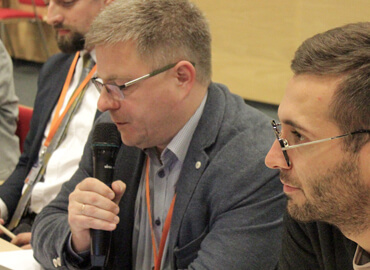Free media is not necessarily viewed as an asset by many politicians. Media in its best form is critical, annoying and persistent, and rebels against any form of political control. Authoritarian politicians tend to consider critical reporting as a personal offence and in many cases, especially when facing no real challenge from opposition parties, target the critical media as their main opponent.
Attempts to control the media are by no means a new phenomenon in the beginning of the 21st century, but the current combination of financial controls, propaganda and disinformation as seen in some Central European countries, can effectively destroy democratic societies. Hungary is a textbook-case of how to minimise critical public discourse and cement your power with the help of the media. Here are the most important steps:
Nationalize and centralize
Hungary’s governing party Fidesz has always been conscious of the importance of the media. PM Orbán, after losing the elections in 2002, allegedly blamed the leftist media for the defeat and wanted to reassure that this was not going to happen again. Fidesz and Orbán used their eight years in opposition to build up a loyal media empire, from radio, daily, weekly and even a TV channel. This was a very conscious strategy orchestrated by Lajos Simicska, a businessman who used to be the treasurer of Fidesz. After gaining supermajority in 2010, the Hungarian government took over not only the public media – which is unfortunately a usual thing in Central Europe – but deliberately searched for opportunities to buy out foreign media companies. Timing was excellent: with the financial crisis slashing advertisement revenues, most foreign media investors were contemplating to leave the Hungarian market, and looked for favourable deals. Media buyouts in Hungary were mainly financed by taxpayers money and in non-transparent manner, using often middlemen.
The first victim to fall was critical online site Origo (previously owned by Deutsche Telekom) which was sold to the family of Orbán’s chief economic advisor and current Central Bank governor György Matolcsy and gradually converted to the flagship propaganda instrument of the government. It was followed by German TV ProSiebenSat1 handing over the second biggest commercial TV channel TV2 in a non-transparent vendor loan to the management, later ending up in the hands of Fidesz-close businessmen. Leading daily Népszabadság was shut down by Austrian businessmen Heinrich Pecina in 2016. Pecina was also involved in a corruption affair and indicted for fraud and misuse of funds in Austria. Last year, Austrian far-right party leader Heinz-Christian Strache (FPÖ) claimed in his scandalous Ibiza video that he wanted to buy up media “just as Viktor Orbán did in Hungary”, proving what has already been obvious.
Media experts agree that foreign investors have their share of responsibility for treating their media portfolios purely as an economic investment, disregarding the media’s essential role in upholding a democratic society. As researcher Gábor Polyák said: “Their approach is totally different in the German media market, because they all know, that media is only important until there is a political debate. But without media, there is no real political debate. They helped the Fidesz government kill it. “
The Hungarian strategy to push out foreign investors from the media market was announced by Orbán in 2016, saying that majority ownership in four key sectors – banks, media, energy, retail — should be in Hungarian hands. More precisely, in government-close hands. Interestingly, the usual narrative of “regaining national sovereignty” was less present regarding media take-overs, as they were mostly concealed as business deals with no government participation whatsoever. This was necessary to avoid accusations of political meddling in (or outright takeover of ) in the free media or breaching competitions laws.
The nationalisation and restructuring of the complete media landscape happened in front of the very eyes of the European politicians, culminating in the establishing of the Central European Press and Media Foundation, a mega holding including almost 500 publications, all loyal to the government. News service is centralized in the Hungarian News Agency, and controlled by government spin doctors. As a result, news stories fabricated to support the government’s political narrative can be centrally manufactured and published on the title page of several dozen newspapers at the same time.
This is coupled by a totally disproportionate advertising market, where pro-governmental outlets, regardless their number of their readers are comfortably cushioned by advertisements of either the government or state-owned companies. According to Mérték Media Monitor, outlets belonging to KESMA account for 40% of all news and public affairs revenues in Hungary’s media market. Adding revenues of government-close TV2 and the public media, this amounts to 80% of the revenue. The tool-kit is made, it can be followed anywhere in Europe.
Undermine critical news outlets as fake news factories
Money – especially taxpayers money — can buy almost everything, but chances are that some critical media prevail even in authoritarian countries. Here, the strategy is the following: if you cannot buy it, discredit it. The government’s strategy is to counter any criticism with a conspiracy theory that “leftist-liberal forces are waging a war against Hungary with the help of the pro-migration forces and the Soros-network”. Ridiculous as it may seem, the longer the government and its politicians are repeating this phrase, the more it works on the collective psyche of the society. After all, nobody likes to be attacked from abroad and the automatic reflex is to defend your country.
The emphasis is usually on who is criticizing and not why. Here, the government uses the old political strategy of “killing the messenger”. Constant labelling is also effective: critical news site Index was constantly named as a “leftist-liberal” outlet, alluding that political independence is not possible, and criticism must have a ideological reason. Another critical news site, 444.hu is systematically referred as a “blog” by government politicians to undermine its credibility. The same applies to the foreign media: CNN is called the biggest fake news factory of the world and The New York Times is critical towards Hungary while it is close to the Democrats, as government mouthpiece Origo frames it.
During the corona virus epidemic, the government-financed Századvég Institute created a so-called Fake-News Observer, where they listed some of the critical reporting about Hungary as a consequence of Hungary’s parliament declaring state of emergency for an indefinite time. The public television also got the taste of it, and it launched a news program to debunk fake news, which served more as a new platform to attack and discredit critical journalists and news sites, as a research by Mérték Media Monitoring found. When labelling something as fake-news, there is no room for public debate or discourse. In an increasing black-and white media context – either progovernment or government-critical – anything can be labelled as fake-news, as it is less a factual thing, but rather faith-based. If a media consumer encounters news which don’t fit his or her political narrative, he or she can easily identify it as fake news. And since the government’s camp is a more monolithic unity, less prone to criticism, they tend to accept everything contrary to their beliefs as fake news. In the government-critical camp, however, this narrative can create more uncertainty.
Discrediting critical media and going as deep as personal attacks against some well-known journalists has some tradition in Hungary. In a TV program in government-close HírTV, two “talking heads”, Márton Békés and Gábor Megadja elaborated on whose side the critical media is really on, in the fight against the corona virus? They attacked the “opposition” channels for being critical towards some government measures, and called them “the collaborators” of the virus. “I would suggest they (those journalists )should be arrested” – voiced Gábor Megadja, a researcher of government funded Századvég Institute. This all happened after the parliament passed a bill in which spreading of fake news could be punished with up to five years of jails. It does not imply that the government was seriously contemplating imprisoning journalists but served perfectly the purpose of intimidation and undermining credibility. Previously, at the end of 2019, a poster of two well-known journalists of critical news site Index appeared in the streets of Budapest with a slogan: “We too came from beyond the border”, alluding to their Jewish roots. A subtitle was added: Index is anti-Hungarian and traitor. There was no evidence of government involvement but it indicated that being a critical journalist does have a certain connotation of being against your nation. These developments clearly serve the purpose of undermining the credibility of critical media, and the media, in general.
If necessary, the government media does not refrain from fabricating fake news either. When the entire editorial staff of Hungary’s most read news site, Index resigned (July 24) citing outside pressure and attempts to restrict their independence, government-loyal Origo published a conspiracy theory about the in-fighting of journalists and how two opposition parties, Democratic Coalition and Momentum struggle to control the news site. The theory – without any evidence – went viral in both in government and in social media. The narrative also served to undermine the society’s belief in independent reporting and in the integrity of journalists.
Disseminate your propaganda abroad
After conquering at least half of the Hungarian media landscape, government-close media entrepreneurs extended their network beyond the borders. Péter Schatz – a close associate of Orbán’s main communications advisor, Árpád Habony — has obtained several TV stations and media outlets in the Western Balkans since 2017, mostly in North Macedonia and in Slovenia. According to investigate news site Direkt 36, Orbán saw Hungary (and his party) to become an important actor in the region, therefore he was consciously buying friends and influence. Media is a safe investment, because you do not end up being accused of illegal party financing, the news site explained, but you can effectively support political allies like former prime minister Nikola Gruevski in North Macedonia and current PM Janez Jansa in Slovenia. Hungary has spent at least 1,4 billion HUF on acquiring media outlets beyond the borders. But goes far beyond being a financial investment: the narrative offered by those media outlets is echoing the similar slogans and propaganda against migration and the so-called Soros network, and undermining the belief in the EU as in the Hungarian sister newspapers.
After setting foot in the region, a media venture in London was also launched. The V4NA (Visegrad Four News Agency) was promoted as an independent international news agency which covers European developments from the perspective of the V4. Launched supposedly with a team of 50 journalists and reporting from nine capitals, it had the ambition to become an influential source of news service for the region. Up to know, V4NA could only establish its positions in the Hungarian government-loyal media, where it has become the third biggest source of international news. The typical V4NA story is about the adverse effects of migration, the criticism of the European bureaucracy and the debunking the latent dominance of the so-called Soros network in practically everywhere in Europe. Some of their stories make their ways into the Macedonian or Slovenian media controlled by friendly entrepreneurs, but a real breakthrough – influencing public discourse in Central Europe, let alone, Western Europe – has not been achieved yet.
***
Edit Inotai,
Senior Fellow
Centre for Euro-Atlantic Integration and Democracy (CEID)
***
This article is published as part of the Prospect Foundation project “Online Media Literacy for Editors and Administrators of Social Media Public Pages”, managed by iSANS and supported through grants from the International Visegrad Fund.










